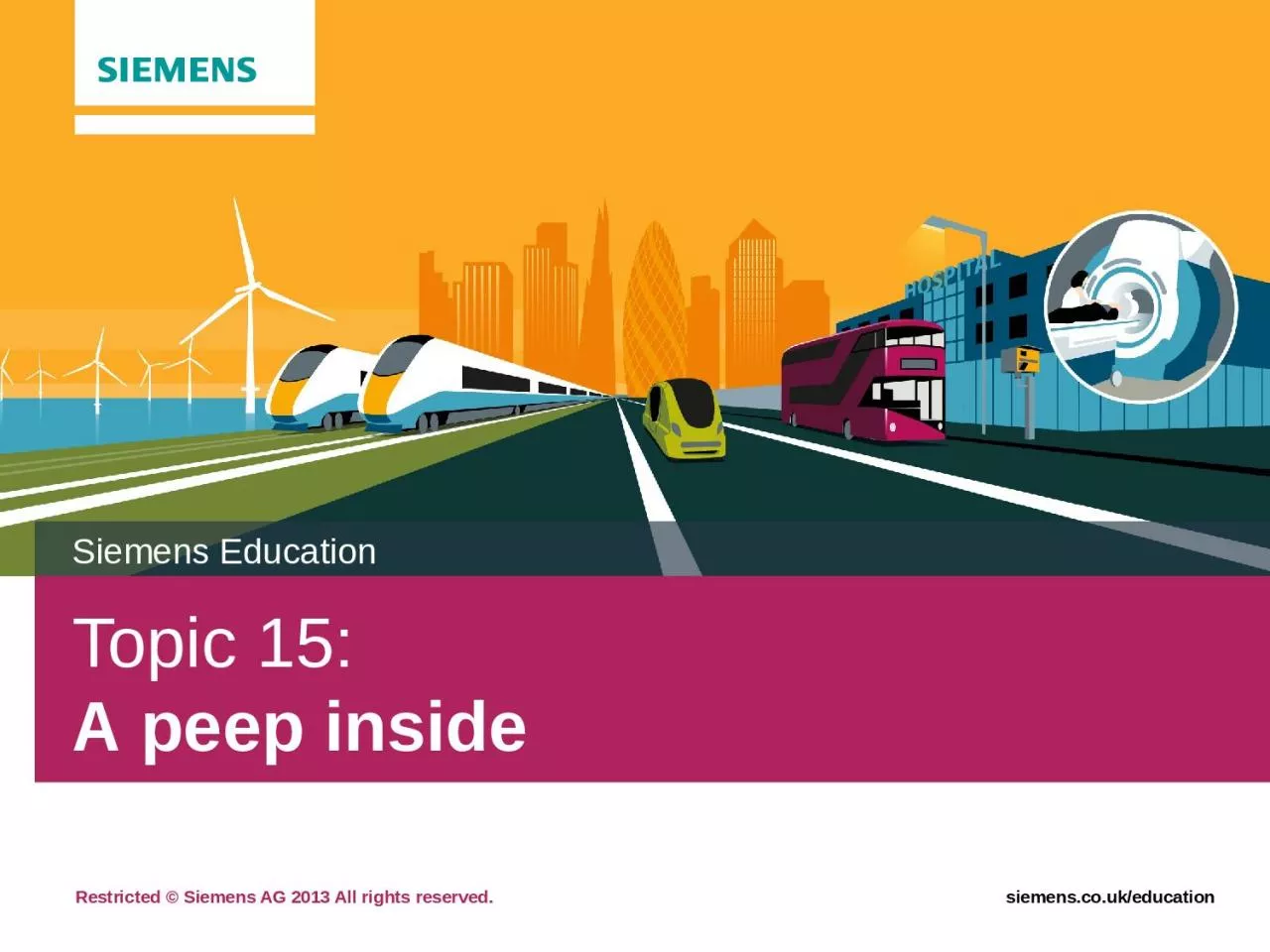

Siemens Education A peep inside Course requirements for GCSE Physics Students should Develop knowledge and understanding of the relationship between the properties of electromagnetic waves and their uses ID: 931898
Download Presentation The PPT/PDF document "Topic 15: A peep inside" is the property of its rightful owner. Permission is granted to download and print the materials on this web site for personal, non-commercial use only, and to display it on your personal computer provided you do not modify the materials and that you retain all copyright notices contained in the materials. By downloading content from our website, you accept the terms of this agreement.
Slide1
Topic 15: A peep inside
Siemens Education
Slide2A peep insideCourse requirements for GCSE Physics
Students should:
Develop knowledge and understanding of the relationship between the properties of electromagnetic waves and their uses
Use scientific theories, models and evidence to develop hypotheses, arguments and explanations
Develop and use models to explain systems, processes and abstract ideas
Slide3A peep insideLearning objective
We are learning to:
Explain how MRI scanners produce images
Apply their understanding of waves and particles to this application
Describe typical uses of MRI images
Slide4A peep inside
How can a doctor make the best possible diagnosis?
Slide5A peep insideThe importance of images
There are various situations in which medical diagnosis will be assisted by detailed imaging, such as broken bones, tumours, etc and the pros and cons of various imaging technologies, such as ultrasound, CT scans, X-rays and MRI scans, need to be considered
X-rays are often used for the imaging of hard material such as bones
Ultrasound is quick and easy but gives lower resolution images
CT scans are high quality but only work in one plane, whereas MRI scans can work in any plane, producing high quality images of the inside of the body from the desired perspective
CT and X-ray imaging uses ionising radiation
Slide6A peep inside
CT Scan
Ultrasound Scan
MRI Scan
X-ray image
Slide7A peep inside
A carbon atom
A hydrogen atom
Atomic structure
Slide8A peep inside
What does an MRI scanner consist of?
There are four key components:
A powerful permanent magnet
Gradient coils, which produce a variable magnetic field
Radio frequency (RF) coils, which produce radio waves
Scanner, which detects energy emitted from the body
Slide9A peep inside
How does MRI work? (1)
Although there are many different elements in the body, hydrogen is very common. It is present in water and in fats. Hydrogen nuclei are the key to the production of MRI scans.
Normally, these nuclei spin in random directions around their individual magnetic fields.
Slide10A peep inside
How does MRI work? (2)
The MRI scanner has a powerful magnet, which produces a magnetic field, many times stronger than that of the Earth. In this magnetic field the nuclei line up either north or south. About half go each way, but there are a few unmatched ones.
Slide11A peep inside
How does MRI work? (3)
When radio waves are produced by the RF coils, the unmatched nuclei spin the other way. The gradient magnets alter the magnetic field so that images can be produced from any direction.
Slide12A peep inside
How does MRI work? (4)
When the radio frequency coils are switched off and the pulse of RF waves stops, the extra nuclei return to their normal position, emitting energy.
Slide13A peep inside
How does MRI work? (5)
The energy released by these nuclei is detected by the scanner, which sends a signal to the computer, which converts it to an image.
Slide14A peep insideWhat advantages does MRI offer?
It can work in any plane: think of the different directions one could slice an apple in. Each slice is a two dimensional view; this is what the images are like. Being able to select the plane offers medical staff real advantages
The images have a very high resolution: the detail is good and it can discriminate between matter that is similar
There are no known biological hazards with MRI: it doesn’t use ionising radiation
Slide15A peep insideWhat are the drawbacks?
Noise: continuous hammering around
Patient has to be still for anything up to 90 minutes: movement causes blurring and requires a repeat scan
Expensive: complex equipment which needs skilled operation and takes time to scan
Claustrophobic: some patients find it unpleasant
Dangerous: magnetic materials can be caused to fly across the room
Slide16A peep inside
Typical diagnostic application: slipped disc
Slide17A peep inside
Typical diagnostic application: slipped disc
Nerves in this area are compromised from the pressure of the prolapsed disc
Slide18A peep inside
Typical diagnostic application: sprained wrist
(if compressed gives pain, swelling and restriction of movement)
(Tendons of the wrist)
(Nerve and artery of the ulna bone run through here to the hand)
(One of the bones in the wrist)
Slide19A peep inside
Sample assessment task
This diagram shows a simplified cutaway view of an MRI scanner
Explain how it produces images for clinical diagnosis (6)